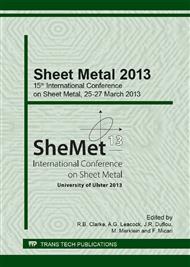p.231
p.239
p.247
p.255
p.262
p.270
p.277
p.284
p.295
Dynamic Strength Behaviour of Punch Connections in Shear Cutting Processes
Abstract:
Two basic types of load for the tool active elements can be distinguished for the shear cutting process of sheet metal. For high strength, brittle materials, the stamping punch will be exposed to distinctive oscillating axial dynamic loads as a result of abrupt released potential energy, from the tool active elements, the blanking tool and the stamping press, caused by a sudden cracking of the sheet. In contrast, when shear cutting ductile materials, sheet metal will be drawn into the die clearance and the resulting friction between the punch and the cut surface can cause high forces when pulling the punch out of the hole. When using punches featuring a complex cutting peripheral form, - not available as a standard part - it is necessary to decide between head and shank of the punch manufactured out of one part or a shaft without head, which is usually cheaper and can be manufactured by electro-erosive wire-cutting. In the second case, a linking element must be accepted, transferring the load transmission between shaft and tool. This linking element, realized by a form lock or traction, can be the reason for premature failure of the punch. The two described cases of load, in combination with lacking knowledge of the real load on the link as well as eligibility of different punch linking types for each case of loading, cause unnecessary cost in tool manufacturing by oversizing or punch fracture. For this, solid punches as well as joined punches with dowelled or screwed heads have been compared in systematic tests. Brazed and bonded punch heads have been involved in the test series as cost-efficient alternatives to custom punches. Collaterally, characteristic values have been determined for each type of punch in static and dynamic measurements. Especially impact absorption and stiffness of the connection represent non-destructive measureable values allowing a comparison of stamping punches in terms of their dynamic fatigue limit.
Info:
Periodical:
Pages:
262-269
Citation:
Online since:
April 2013
Authors:
Keywords:
Price:
Сopyright:
© 2013 Trans Tech Publications Ltd. All Rights Reserved
Share:
Citation:


